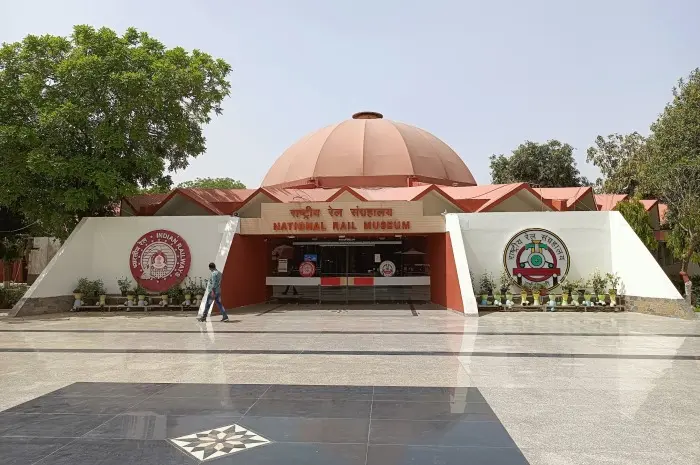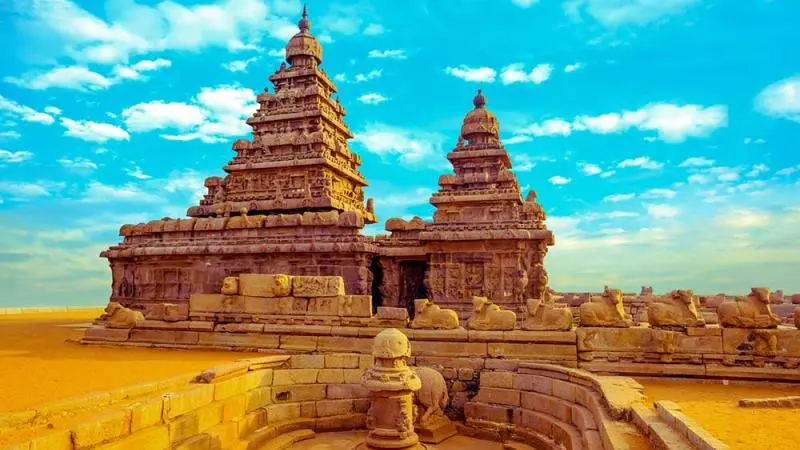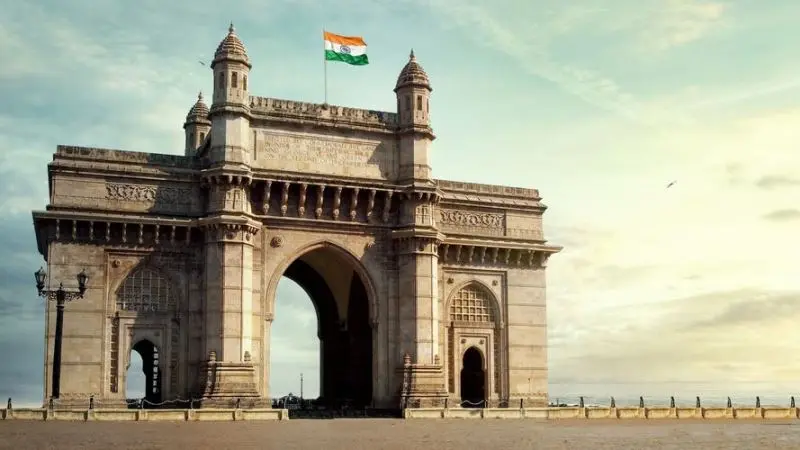| Entry Fee: 540 INR; Location: Check Map Address: Dharmapuri, Forest Colony, Tajganj, Agra, Uttar Pradesh, India. |
The Taj Mahal, located in Agra, India, is an iconic masterpiece and one of the most recognized architectural wonders in the world. It stands as a symbol of eternal love and is considered a testament to the grandeur of Mughal architecture. The Taj Mahal’s exquisite beauty, intricate craftsmanship, and profound symbolism have made it a UNESCO World Heritage site and a must-visit destination for travelers from around the globe.
Built in the 17th century by the Mughal emperor Shah Jahan, the Taj Mahal was dedicated to his beloved wife, Mumtaz Mahal, who passed away during childbirth. The mausoleum serves as her final resting place and is a monument to their eternal love. The Taj Mahal’s enchanting allure lies not only in its architectural splendor but also in the profound love story that inspired its creation.
Visiting the Taj Mahal is an awe-inspiring experience. As you approach the complex, the white marble structure emerges, seemingly floating on the banks of the Yamuna River. The symmetrical layout, intricate carvings, and shimmering reflections in the surrounding pools create a mesmerizing sight that leaves visitors spellbound.
Beyond its architectural beauty, the Taj Mahal holds cultural and historical significance. It is a symbol of India’s rich heritage and the influence of Mughal art and culture. The intricate calligraphy, delicate marble inlay work, and the use of precious gemstones reflect the artistic brilliance and attention to detail characteristic of the Mughal era.
1. The History of Taj Mahal Agra
1. Construction Period and Purpose
The construction of the Taj Mahal began in 1632 and took over 20 years to complete. It was commissioned by Emperor Shah Jahan, the fifth Mughal ruler of India, as a mausoleum for his beloved wife, Mumtaz Mahal. Mumtaz Mahal passed away in 1631, and in her memory, Shah Jahan envisioned a grand structure that would reflect their eternal love.
2. Patron and Architect
The Taj Mahal was primarily the vision of Emperor Shah Jahan, who spared no expense in creating a monument that would be unrivaled in its beauty. He enlisted the finest architects, artisans, and craftsmen from across the Mughal Empire and beyond. The chief architect of the Taj Mahal was Ustad Ahmad Lahauri, who brought together a team of skilled craftsmen to execute Shah Jahan’s vision.
3. Symbolism and Love Story
The Taj Mahal stands as a symbol of enduring love. According to historical accounts, Shah Jahan was deeply devoted to Mumtaz Mahal, and her sudden death shattered him. The Taj Mahal was constructed as a mausoleum to house her tomb and to immortalize their love. It is said that Shah Jahan’s grief and longing for his beloved wife found expression in the grandeur and beauty of the Taj Mahal.
The symmetry of the Taj Mahal’s design represents the balance and harmony of love, while the minarets symbolize the gateway to heaven. The intricate carvings and calligraphy on the marble walls include verses from the Quran and intricate floral motifs, showcasing the artistic mastery of the craftsmen involved in its construction.
The Taj Mahal’s profound love story and its architectural brilliance have captured the imagination of people around the world, making it an enduring symbol of romance and beauty.
As you delve deeper into the history of the Taj Mahal, you will discover the remarkable story of love, devotion, and artistic excellence that continues to fascinate and inspire visitors to this day.
2. The Taj Mahal’s Architecture

1. Exterior Design of the Taj Mahal
The Taj Mahal’s exterior is a masterpiece of Mughal architecture, characterized by its white marble construction and meticulous attention to detail. The mausoleum stands on a raised platform, accentuating its grandeur and providing a commanding presence.
- White Marble Construction: The Taj Mahal is entirely constructed using white Makrana marble, which gives it its ethereal and luminous appearance. The marble was sourced from Rajasthan and transported to Agra, where it was meticulously carved and shaped by skilled craftsmen.
- Symmetry and Balance: The Taj Mahal exhibits exceptional symmetry and balance in its design. It is perfectly symmetrical, with identical elements on each side, creating a sense of harmony and visual appeal. The four minarets at each corner of the mausoleum add to its balanced composition.
- Main Gateway (Darwaza-i Rauza): The main gateway, known as the Darwaza-i Rauza, serves as the entrance to the Taj Mahal complex. It features intricate decorative elements, including calligraphy, floral patterns, and geometric designs. The gateway serves as a prelude to the grandeur that awaits within.
- Minarets and Dome: The Taj Mahal is crowned by a large central dome, rising elegantly above the marble structure. The dome is flanked by four slender minarets that stand at the corners. These minarets serve both decorative and functional purposes and enhance the visual appeal of the monument.
2. Interior Design
The interior of the Taj Mahal is equally breathtaking, featuring intricate craftsmanship and stunning details.
- Intricate Marble Inlay Work (Pietra Dura): The interior walls of the Taj Mahal are adorned with intricate marble inlay work, known as Pietra Dura. Skilled artisans used semi-precious stones, such as jasper, lapis lazuli, and turquoise, to create elaborate floral and geometric patterns. The meticulous craftsmanship and attention to detail are evident in the intricate designs that cover the walls.
- Calligraphy and Quranic Inscriptions: The interior also features calligraphic inscriptions from the Quran, skillfully carved into the marble walls. These inscriptions are adorned with beautiful floral motifs and serve as a reminder of the religious and spiritual significance of the monument.
- Main Mausoleum (Cenotaphs and Crypt): The main mausoleum houses the cenotaphs of Emperor Shah Jahan and Mumtaz Mahal. The cenotaphs are exquisitely carved and inlaid with semi-precious stones. Visitors can view the cenotaphs from a distance, as entry to the actual burial chamber is restricted.
- Decorative Elements and Precious Gemstones: Throughout the interior, visitors can admire intricate floral patterns, geometric designs, and delicate lattice screens. Precious gemstones, including agate and carnelian, are embedded in the marble to enhance the beauty of the intricate artwork.
The architectural marvel of the Taj Mahal lies not only in its external grandeur but also in the intricate details and craftsmanship that adorn its interior. The blend of Persian, Islamic, and Indian architectural styles creates a harmonious and awe-inspiring monument that continues to captivate visitors from around the world.
3. Garden at Taj Mahal Complex
The Taj Mahal is not just a magnificent mausoleum; it is surrounded by a beautiful garden complex that adds to its charm and visual appeal. The garden, known as the Charbagh, is designed in the Persian style and serves as a symbolic representation of paradise.
1. Charbagh Style Garden Layout
Layout and Geometry: The Charbagh garden is divided into four equal quadrants by pathways and water channels, creating a symmetrical and geometric design. This layout reflects the Islamic concept of paradise, which is characterized by order, symmetry, and tranquility.
- Central Water Channel: The garden features a central water channel, known as the Nahr-i-Bihisht or “River of Paradise.” It begins at the entrance of the garden and runs through its length, dividing the garden into equal parts. The water channel is aligned with the reflection pool in front of the Taj Mahal, creating a stunning visual effect.
- Raised Flowerbeds: The Charbagh garden is adorned with raised flowerbeds filled with vibrant flowers and fragrant plants. These flowerbeds add color and fragrance to the garden and enhance its aesthetic appeal.
- Pathways and Symmetry: The pathways in the garden are aligned with the architectural elements of the Taj Mahal, emphasizing the symmetry and balance of the overall design. These pathways allow visitors to stroll through the garden, enjoy the beauty of the surroundings, and approach the mausoleum.
2. Mughal Garden Elements
The garden complex of the Taj Mahal incorporates elements of Mughal garden design, which combines aesthetics with functionality.
- Chahar Bagh Style: The Charbagh garden follows the chahar bagh style, which originated in Persia and was introduced to the Indian subcontinent by the Mughals. This style features a four-fold garden divided by water channels, pathways, and geometric patterns.
- Cypress Trees and Fruit-bearing Trees: The garden is adorned with cypress trees, which are known for their slender and graceful appearance. These trees provide a vertical accent to the garden’s landscape. Fruit-bearing trees, such as mango and citrus, are also found in the garden, adding to its allure.
- Pavilion Structures and Seating Areas: Within the garden, there are pavilion structures and seating areas where visitors can rest and enjoy the serene atmosphere. These pavilions, known as baradaris, provide shaded spots and viewpoints from which the Taj Mahal can be admired.
The garden complex surrounding the Taj Mahal complements its architectural splendor and creates a harmonious setting. The combination of geometric precision, flowing water, lush greenery, and fragrant flowers adds to the ethereal beauty of the monument. The garden provides visitors with an opportunity to immerse themselves in the tranquil ambiance and appreciate the perfect union of nature and architecture.
4. Visitor Experience

1. Entry and Ticketing Information
To visit the Taj Mahal, visitors need to obtain entry tickets. Tickets can be purchased at the ticket counters located near the entrance gate or through online booking platforms. There are separate ticket options for Indian and foreign tourists, with different fees and privileges. It is advisable to check the official website or consult a reliable source for the most up-to-date information on ticketing and entry requirements.
2. Regulations and Guidelines for Visitors
To ensure the preservation of the Taj Mahal and a pleasant experience for all visitors, certain regulations and guidelines are in place. These include:
- Restricted Items: Visitors are not allowed to carry certain items inside the Taj Mahal complex, such as tripods, food, and tobacco products. It is recommended to check the list of prohibited items before visiting to avoid any inconvenience.
- Dress Code: There is no specific dress code, but visitors are advised to dress modestly and respectfully. It is recommended to wear comfortable footwear as you will be walking on marble surfaces.
- Photography: Photography is allowed within the Taj Mahal complex, but the use of tripods and commercial photography may require special permission. Drones are strictly prohibited. It is advisable to be respectful of others and avoid causing inconvenience while taking photographs.
- No Smoking Zone: The Taj Mahal complex is a no-smoking zone to maintain its pristine environment. Visitors are requested to refrain from smoking or using any tobacco products within the premises.
5. Best Time to Visit and Peak Seasons
The Taj Mahal can be visited throughout the year, but certain seasons offer more favorable weather conditions and fewer crowds. The months of October to March, during the winter season, are generally considered the best time to visit as the weather is pleasant and mild. However, this period also experiences higher tourist footfall, so it is advisable to plan your visit accordingly and book tickets in advance to avoid long queues.
Nearby Attractions and Activities
While the Taj Mahal is undoubtedly the highlight of a visit to Agra, there are other notable attractions in the vicinity that visitors can explore. These include:
- Agra Fort: Located nearby, Agra Fort is a UNESCO World Heritage site and offers insights into the Mughal era with its impressive architecture and historical significance.
- Itmad-ud-Daulah’s Tomb: Often referred to as the “Baby Taj,” this beautiful marble mausoleum is another architectural gem worth visiting.
- Mehtab Bagh: Situated across the Yamuna River from the Taj Mahal, Mehtab Bagh offers a serene garden setting with stunning views of the monument, particularly during sunset.
- Local Bazaars: Agra is known for its vibrant bazaars where visitors can shop for handicrafts, textiles, and local specialties like marble artifacts and leather goods.
Visiting the Taj Mahal is an extraordinary experience that allows you to witness the epitome of architectural brilliance and immerse yourself in the rich history and cultural heritage of India. While planning your visit, it is recommended to allocate sufficient time to explore the Taj Mahal complex and nearby attractions, ensuring a comprehensive experience of this iconic landmark.
Conclusion
The Taj Mahal stands as a testament to eternal love, architectural brilliance, and cultural heritage. Its majestic presence, intricate craftsmanship, and profound symbolism have captivated people from all corners of the globe. A visit to the Taj Mahal is a journey into a world of beauty, history, and romance.
As you explore the Taj Mahal, you are transported to an era of opulence and devotion. Its exterior showcases the perfect balance of architectural elements, with its white marble facade, intricate carvings, and graceful minarets. The interior mesmerizes with its marble inlay work, calligraphic inscriptions, and the ethereal atmosphere that envelops the cenotaphs of Shah Jahan and Mumtaz Mahal.
Beyond its physical attributes, the Taj Mahal holds cultural significance that extends to love, spirituality, and artistic inspiration. It has inspired artists, writers, and architects throughout the ages and continues to be an enduring symbol of India’s rich cultural heritage.
Visiting the Taj Mahal is an experience like no other. The serene gardens, the shimmering reflection pool, and the enchanting ambiance create a lasting impression. The cultural importance and global recognition of the Taj Mahal make it a must-visit destination for travelers seeking to immerse themselves in the wonders of India.
As you bid farewell to the Taj Mahal, the memories of its magnificence and the emotions it evokes will stay with you forever. The grandeur and beauty of this architectural marvel are etched in history and continue to inspire generations. The Taj Mahal is more than a monument—it is a symbol of love, a masterpiece of craftsmanship, and a testament to the enduring power of human creativity.
So, embark on your journey, explore the wonders of the Taj Mahal, and let its timeless beauty leave an indelible mark on your soul.







